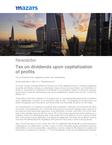
Tax on dividends upon capitalization of profits
Article published on May 14 in “Actualicese.com”
The Dian, through Concept 000449 of February 26, 2019, established that if a company capitalizes its profits and thereby releases (or distributes) shares among its shareholders, such distribution of shares is considered as a distribution of dividends for tax purposes, reason for which the company would have to make the withholding at the source established in Articles 242 and 242-1 of the Tax Statute -ET-.
This position of the Dian is based on a conceptual error or misunderstanding about what is a dividend and a capitalization of profits, so its conclusion lacks all logic. The purpose of this document is to clarify conceptually such instructions, so that the entity may reconsider its opinion on the matter.
As a starting point, it is necessary to analyze what a dividend is. Although our commercial law does not contain a formal definition for it, Article 98 of the Code of Commerce indicates that an element of the essence of the partnership agreement is the distribution of profits, and Article 155 of the same body of law indicates that only with the vote of 78% of the shares represented at the meeting can a company refrain from distributing profits. It also states that in the absence of such majority, at least 50% of the profits must be distributed. It could then be stated that, financially, the dividend is nothing more than the distributed profit, regardless of the period or fiscal year in which it was produced.
Now, from the tax point of view, Article 30 of the ET establishes that dividends or profit sharing are understood as "any distribution of profits, in cash or in kind, charged to equity and made to partners, shareholders, co-owners, associates, subscribers or similar, except for the reduction of capital and the premium in placement of shares (...)". From this definition it can be concluded that the dividend is the effective distribution of the profit, which can be made in cash or in kind (either in shares of the same company, or in shares of other companies or through the delivery of any other corporate asset), provided that it is charged to equity, that is, affecting the corresponding equity accounts as a counterpart to the cash or investments that are paid as dividends.
The concept of internal capitalizations (including the capitalization of profits) refers to the movement of equity accounts by decision of the highest corporate body, whereby the capital account is increased against other equity accounts. In this sense, items that are in the equity accounts of reserves (profits from previous periods), share premium or revaluation of equity (in some specific cases) may become part of the capital account. This operation, since it implies an increase in the subscribed capital, must necessarily have one of two effects: the issuance of new shares at the same par value or the increase in the par value of existing shares.
It follows from the foregoing that not every distribution of shares made by a company to its shareholders must necessarily be assimilated to a dividend in kind. In other words, the natural effect of an internal capitalization is the issuance and distribution of new shares, but this may have no relation whatsoever with the profit (for example, in the case of the capitalization of the additional paid-in capital or the revaluation of equity). Or it could indeed have one, in the case of the capitalization of profits, but even there it could not be said that the profit is being distributed in kind by the mere fact of releasing shares when capitalizing profits. To sustain this thesis, the Dian would have to prove that in the case that the profits were capitalized -not by issuing new shares, but by increasing the nominal value of the already existing ones- the dividend tax would also be generated, which is logically and legally impossible.
It is also inconvenient this position of the Dian, since there are many mechanisms to leave the profits of the companies in their equity, without necessarily having to capitalize them; occasional reserves can be constituted (which decrease the distributable dividend) or take them as retained earnings, although these (being a liability) generate interest in favor of the partners or shareholders and can be collected enforceably. This position would discourage the capitalization of profits, which, in addition to strengthening the equity of the companies, can - in certain cases - prevent the grounds for dissolution due to losses.
In conclusion, it cannot be stated that even if the legal effect of two operations is the same (the distribution of shares), they refer to only one. When a company pays its dividend in shares, it does so in order not to affect its cash flow, and there the Dian already stated (through its Concept 000018 of January 10, 2019) that it would apply the dividend tax. But when what is wanted is not to distribute profits and it is decided to capitalize them, obtaining as a consequence that shares are released (also being able to choose not to release shares but to increase the nominal value of the same), such operation cannot be taxed with the dividend tax, since the underlying business is not the distribution of profits, but quite the opposite: their capitalization.


